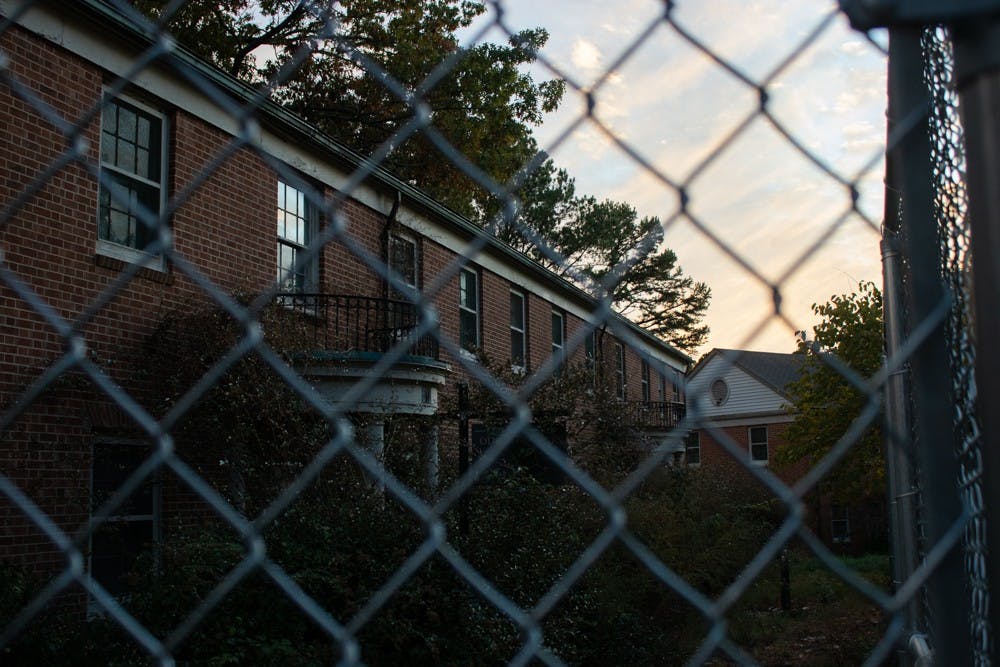We in my department, which is facilities planning and design, we manage on an average year, a typical year, a couple hundred projects … We do those projects all the time and that’s not really what the Master Plan is trying to address.
The Master Plan is really if we build a new building, if we do a major renovation, expansion, or addition to an existing building, if we are demolishing a bunch of buildings, if we’re building a new road. It’s something that’s going to have a much more significant impact to the entire campus and how the entire campus works.
I think the COVID impact had a lot of impact to those smaller projects that work at the departmental level or in one school’s building. These larger projects are, in some ways, a different animal.
DTH: What is happening with Odum Village?
Yassky: So, on the southern part, the far southern part of the main campus … there were — I have to remember — say 35 or so of these small buildings.
The first phase, if you will, of that larger vision, which is a big piece of the Master Plan, was to demolish these Odum Village buildings, and that work continued even during COVID times, although I guess you could say that if not for COVID, we might have demolished more of them. We demolished maybe half of them. But we’ve opened up a pretty good amount of land now that’s just open, there’s no buildings on it, that area of campus. Which will allow us, at some future point, to develop this innovation hub, which, frankly, the addition to the business school, I think of as a piece of that.
DTH: What is happening with Porthole Alley, the area where campus meets Franklin Street at the Visitors Center?
Yassky: There’s a foundation, called the Chapel Hill Foundation, that — it does a lot of things — but it exists to support the mission of the University … They owned a chunk of the area around Porthole Alley, and so, my department partnered with the foundation to look at this redevelopment project at Porthole Alley … Where the new Visitors Center was created is the same location. It’s in that same building, and then there’s actually two neighboring buildings that are all part of this redevelopment project.
That is a project that was started just a little bit pre-COVID. I think at the end of 2019, the project started ... But we have not worked together with the foundation to design a building. Technically, that process is still ongoing at a much slower pace.
DTH: Is there another mass transit project in the works since the light rail project was canceled, and is it continuing?
Yassky: It’s true that the light rail project was canceled … And it was really just as we were kind of wrapping up and getting the Master Plan prepared to send to the trustees for their approval that this announcement was made that the light rail project was going to be canceled.
There has now, since the death of the light rail project, been a lot of activity on what’s called BRT — bus rapid transit. One piece of that, which is a north-south running transit line, has gotten pretty far along that would go from the north part of Chapel Hill through town and campus and continue south towards Chatham County.
To get the day's news and headlines in your inbox each morning, sign up for our email newsletters.
DTH: Are there any projects with residence halls that are being changed?
Yassky: There’s nothing that we were in the middle of or about to start that went on hold, with the exception of one project. One project that we did put on hold for Allan (Blattner) and his group — it wasn’t really tied to the Master Plan, it was dealing with some infrastructure issues on one of the buildings. It was modernizing or repairing and that sort of thing. It wasn’t transformation or adding to or knocking one down or building a new building.
DTH: Are classrooms or interiors being renovated?
Yassky: Because we’re a little older and we’ve received less money from the state for those sorts of things over the last decade, it’s built up this reserve of what we call deferred maintenance.
The Master Plan itself, I would say, puts a spotlight on some of that, and we have the mapping of which buildings have what level of deferred maintenance. The Master Plan didn’t specify how we would implement that, or how we would address the problem of deferred maintenance.
It’s saying, "Here’s where it is, we acknowledge that it exists, and we’re going to have to work on that."
university@dailytarheel.com



